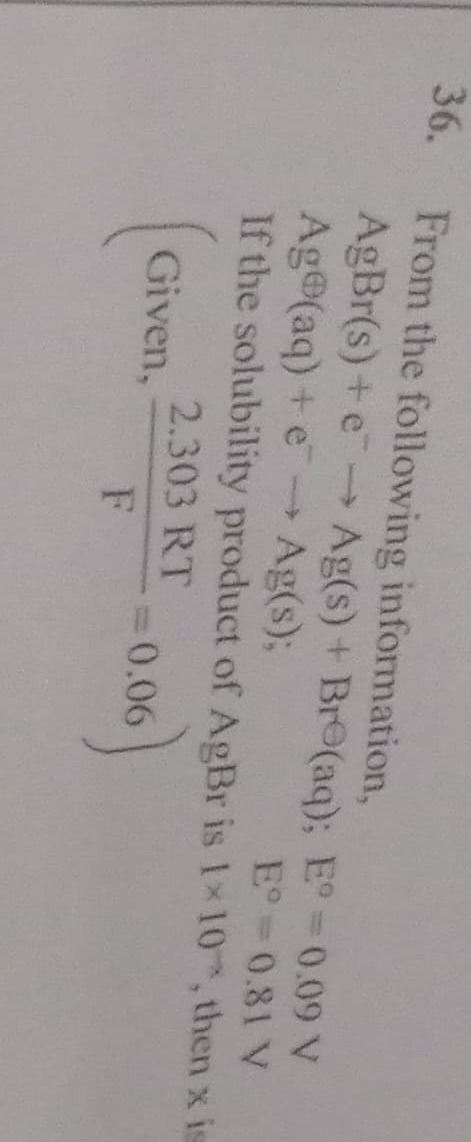Question
Question: From the following information, AgBr(s) + e → Ag(s) + Bre(aq); E° = 0.09 V Ag⊕(aq) + e → Ag(s); E° ...
From the following information,
AgBr(s) + e → Ag(s) + Bre(aq); E° = 0.09 V Ag⊕(aq) + e → Ag(s); E° = 0.81 V If the solubility product of AgBr is 1x10⁻ˣ, then x is
(Given,F2.303RT=0.06)

12
Solution
To determine the solubility product (Ksp) of AgBr, we need to relate the given standard electrode potentials to the equilibrium reaction for AgBr dissolution.
The solubility product of AgBr is defined by the equilibrium: AgBr(s)⇌Ag+(aq)+Br−(aq) Ksp=[Ag+][Br−]
We are given two standard electrode potentials:
- AgBr(s)+e−→Ag(s)+Br−(aq); E1∘=0.09V
- Ag+(aq)+e−→Ag(s); E2∘=0.81V
To obtain the reaction AgBr(s)⇌Ag+(aq)+Br−(aq), we can subtract the first half-reaction from the second half-reaction: (Ag+(aq)+e−→Ag(s))−(AgBr(s)+e−→Ag(s)+Br−(aq)) This yields: Ag+(aq)−AgBr(s)→−Br−(aq) Rearranging, we get the reaction: Ag+(aq)+Br−(aq)→AgBr(s)
The standard cell potential (Erxn∘) for this reaction is the difference between the standard electrode potentials of the two half-reactions: Erxn∘=E2∘−E1∘=0.81V−0.09V=0.72V
The equilibrium constant for the reaction Ag+(aq)+Br−(aq)→AgBr(s) is K=[Ag+][Br−]1=Ksp1.
Now, we use the relationship between the standard cell potential and the equilibrium constant, which is derived from the Nernst equation: Erxn∘=nF2.303RTlogK Given F2.303RT=0.06V. The number of electrons transferred (n) for this reaction is 1 (as seen from the half-reactions).
Substitute the values into the equation: 0.72V=10.06log(Ksp1) 0.72=0.06(−logKsp) Divide both sides by 0.06: −logKsp=0.060.72 −logKsp=12 logKsp=−12
To find Ksp, take the antilog: Ksp=10−12
The problem states that the solubility product of AgBr is 1×10−x. Comparing our calculated Ksp with the given form: 1×10−x=1×10−12 Therefore, x=12.
